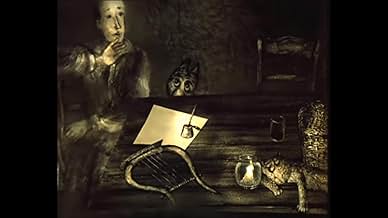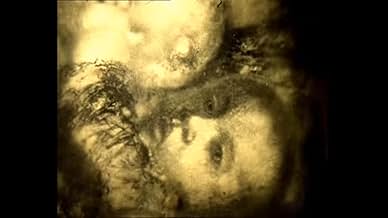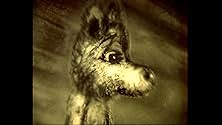Skazka skazok
- 1979
- 29min
CALIFICACIÓN DE IMDb
7.8/10
4.4 k
TU CALIFICACIÓN
Agrega una trama en tu idiomaDistant, well-worn memories of childhood are inhabited by a little gray wolf. Through astonishing imagery, the memory of all of Russia is depicted.Distant, well-worn memories of childhood are inhabited by a little gray wolf. Through astonishing imagery, the memory of all of Russia is depicted.Distant, well-worn memories of childhood are inhabited by a little gray wolf. Through astonishing imagery, the memory of all of Russia is depicted.
- Dirección
- Guionistas
- Elenco
- Premios
- 2 premios ganados en total
- Dirección
- Guionistas
- Todo el elenco y el equipo
- Producción, taquilla y más en IMDbPro
Opiniones destacadas
The human memory does not operate in a straightforward, linear manner. We do not remember events in neat chronological order, nor do we always immediately understand the meaning behind what we are seeing. Our memories are a jumble of seemingly-random but ultimately connected images, sporadically jumping between remembered places and moments, associations triggered by the repeated appearance of deceptively mundane but eerily familiar objects. There is much to be learned from exploring the unfathomable depths of the mind, and Russian animator Yuriy Norshteyn's 'Tale of Tales' strives to do exactly that.
In 1984, in an event held in conjunction with the Los Angeles Olympics, the Animation Olympiad jury attempted to recognise the single greatest animated film of all time. Despite a wealth of worthy candidates, one film was ultimately crowned with the grand title: that film, of course, was 'Tale of Tales.' Two decades later, at the 2002 Zagreb World Festival of Animated Films, the same film was honoured with the same prestigious title, confirming beyond doubt that time has done nothing to dampen its beauty. Norshteyn's masterpiece is a triumph of stunning animation, ambient sound and a stirring classical score. Despite being held in such high regard by so many animation experts, I was surprised to discover how rare and under-seen this film actually is. Only via the internet was I able to watch it, and my hearing about it in the first place can be put down to blind luck. Needless to say, I am infinitely grateful that I did stumble upon the film one day.
'Tales of Tales' is comprised of a number of related sequences, which are interspersed within each other. The film uses several recurring characters, most notably the poet, the little girl playing jump-rope with the disheartened bull, the young boy feeding apples to the crows, the dancers and the soldiers, the suckling baby and, of course, the little grey wolf (voiced by Aleksandr Kalyagin). The meanings behind the film's poignant images are somewhat beyond words, and, even if you have absolutely no desire to try and decipher the rich symbolism, you can still simply sit back and take in the awesome beauty. The sequences involving the dancers are most certainly an allegory for Russia's involvement in World War Two. The vanishing male dance partners, replaced by hooded Grim Reapers who retreat solemnly into the distance, highlight the enormous human losses the Soviet Union suffered on the Eastern Front.
The original title of the short, 'The Little Grey Wolf Will Come,' was derived from a traditional Russian lullaby, which is featured in the film in both instrumental and vocal form: "Baby, baby, rock-a-bye / On the edge you mustn't lie / Or the little grey wolf will come / And will nip you on the tum / Tug you off into the wood / Underneath the willow-root." This title, however, was ultimately rejected by the Soviet censors, and Norshteyn was forced to choose another one. He eventually decided upon 'Tale of Tales,' the title of a poem by Turkish poet Nazim Hikmet, of which the director had been a fan since 1962: "We stand above the water - sun, cat, plane tree (platanus tree), me / and our destiny. / The water is cool, / The plane tree is tall, / The sun is shining, / The cat is dozing, / I write verses. / Thank God, we live!" The film employs an original music score by Mikhail Meyerovich, supplementing his contributions with the classic works of Bach, Mozart and the World War Two era tango, 'Weary Sun,' written by Jerzy Petersburski.
Curiously, 'Tale of Tales' completed in 1979 is the most recent film directed by Yuriy Norshteyn. This, however, does not mean that he has not been working hard. Ever since 1981, the director has dedicated most of his time to producing 'Shinel / The Overcoat,' his 60-minute labour of love, adapted from Nikolai Gogol's short story of the same name. Throughout a production period plagued with interruptions and financial difficulties, Norshteyn's ardent perfectionism has earned him the nickname, "The Golden Snail." A release date for 'The Overcoat' is currently uncertain, but, if the magnificent 'Tale of Tales' is anything to go by, we are all in for a treat!
In 1984, in an event held in conjunction with the Los Angeles Olympics, the Animation Olympiad jury attempted to recognise the single greatest animated film of all time. Despite a wealth of worthy candidates, one film was ultimately crowned with the grand title: that film, of course, was 'Tale of Tales.' Two decades later, at the 2002 Zagreb World Festival of Animated Films, the same film was honoured with the same prestigious title, confirming beyond doubt that time has done nothing to dampen its beauty. Norshteyn's masterpiece is a triumph of stunning animation, ambient sound and a stirring classical score. Despite being held in such high regard by so many animation experts, I was surprised to discover how rare and under-seen this film actually is. Only via the internet was I able to watch it, and my hearing about it in the first place can be put down to blind luck. Needless to say, I am infinitely grateful that I did stumble upon the film one day.
'Tales of Tales' is comprised of a number of related sequences, which are interspersed within each other. The film uses several recurring characters, most notably the poet, the little girl playing jump-rope with the disheartened bull, the young boy feeding apples to the crows, the dancers and the soldiers, the suckling baby and, of course, the little grey wolf (voiced by Aleksandr Kalyagin). The meanings behind the film's poignant images are somewhat beyond words, and, even if you have absolutely no desire to try and decipher the rich symbolism, you can still simply sit back and take in the awesome beauty. The sequences involving the dancers are most certainly an allegory for Russia's involvement in World War Two. The vanishing male dance partners, replaced by hooded Grim Reapers who retreat solemnly into the distance, highlight the enormous human losses the Soviet Union suffered on the Eastern Front.
The original title of the short, 'The Little Grey Wolf Will Come,' was derived from a traditional Russian lullaby, which is featured in the film in both instrumental and vocal form: "Baby, baby, rock-a-bye / On the edge you mustn't lie / Or the little grey wolf will come / And will nip you on the tum / Tug you off into the wood / Underneath the willow-root." This title, however, was ultimately rejected by the Soviet censors, and Norshteyn was forced to choose another one. He eventually decided upon 'Tale of Tales,' the title of a poem by Turkish poet Nazim Hikmet, of which the director had been a fan since 1962: "We stand above the water - sun, cat, plane tree (platanus tree), me / and our destiny. / The water is cool, / The plane tree is tall, / The sun is shining, / The cat is dozing, / I write verses. / Thank God, we live!" The film employs an original music score by Mikhail Meyerovich, supplementing his contributions with the classic works of Bach, Mozart and the World War Two era tango, 'Weary Sun,' written by Jerzy Petersburski.
Curiously, 'Tale of Tales' completed in 1979 is the most recent film directed by Yuriy Norshteyn. This, however, does not mean that he has not been working hard. Ever since 1981, the director has dedicated most of his time to producing 'Shinel / The Overcoat,' his 60-minute labour of love, adapted from Nikolai Gogol's short story of the same name. Throughout a production period plagued with interruptions and financial difficulties, Norshteyn's ardent perfectionism has earned him the nickname, "The Golden Snail." A release date for 'The Overcoat' is currently uncertain, but, if the magnificent 'Tale of Tales' is anything to go by, we are all in for a treat!
In most people's head the animation film is connected to Disney movies or to Japanese manga animation films, which are very hip nowadays. But everyone seems to overlook Russian animators. The most influential of them is Yuri Norstein, whose timeless masterpiece was awarded at the festival of animation films in Los Angeles in 1984 and at many other film festivals throughout the world. But why is this short half-an-hour movie so beautiful?
Firstly, because Norstein has a matchless visual style. I expected something special after I've read about the film and before I saw it but what I got is something extraordinary: breathtaking pictures, fantastically clever use of mixed media, fine classical music. Secondly, because of the complex, symbol-ridden story, which is rooted in the Russian mythology. The story is about childhood innocence, the loss of the loved ones and the duty of the artist. It's very European, very Eastern-European and because I'm from Hungary and our past is very similar, this animation film is much closer to me than the American or Japanese ones.
Firstly, because Norstein has a matchless visual style. I expected something special after I've read about the film and before I saw it but what I got is something extraordinary: breathtaking pictures, fantastically clever use of mixed media, fine classical music. Secondly, because of the complex, symbol-ridden story, which is rooted in the Russian mythology. The story is about childhood innocence, the loss of the loved ones and the duty of the artist. It's very European, very Eastern-European and because I'm from Hungary and our past is very similar, this animation film is much closer to me than the American or Japanese ones.
Great film. The scene of child with birds remind me the almost same scenes form Andrei Tarkovsky's "the Mirror". I see this film on DVD(the collection of Russian Animation films), the effect is marvelous! The total film like a dream, sometimes make you feel bitter, sometimes smile with tears. I like the prelude and fuge by Bach in this film, and the tango music is also used in Nikita Mikhalkov's film " Burnt by the Sun". The Great film(not only the animation film) I have ever seen.
10kamerad
I must discuss the Russian Yuri Norstein's stunning "Tale of Tales". Like the films of another great Russian filmmaker, Andrei Tarkovsky, this film is about memory and nostalgia. The uses of various techniques of animation, primarily cutouts, not only let us see Norstein's memories, but also help illustrate their dream-like qualities. There are events in this film that, taken literally, could not have happened. However Norstein represents these memories metaphorically, thereby making their emotional impact greater than were he to simply illustrate his memories in a straight forward narrative.
There are a couple of moments that reflect the above-mentioned statement that I feel I must include in this entry. I loved the scene where the little boy is standing in the snow eating an apple , looking up at some crows on a tree branch. The boy then appears on the branch, buddies up with the crows and shares his apple with them. This is a great, moving, but non-sentimental image that lets us feel the child's desire for friendship. Just after that, his father, whose Napoleon hat identifies him as a tyrant, yanks him out of his daydream. The little boy at first struggles, but then a little Napoleon hat appears on his head and he marches in file behind his dad. This scene reminded me of the Disney WWII era short "Education for Death", in that it also is about childhood innocence being destroyed by adults conditioning their behavior. But where "Education." was a didactic propaganda tool, "Tale of Tales" simply shows how sad and unfortunate it is for adults to do that to children, and illustrates it in such a poetic way.
There are a couple of moments that reflect the above-mentioned statement that I feel I must include in this entry. I loved the scene where the little boy is standing in the snow eating an apple , looking up at some crows on a tree branch. The boy then appears on the branch, buddies up with the crows and shares his apple with them. This is a great, moving, but non-sentimental image that lets us feel the child's desire for friendship. Just after that, his father, whose Napoleon hat identifies him as a tyrant, yanks him out of his daydream. The little boy at first struggles, but then a little Napoleon hat appears on his head and he marches in file behind his dad. This scene reminded me of the Disney WWII era short "Education for Death", in that it also is about childhood innocence being destroyed by adults conditioning their behavior. But where "Education." was a didactic propaganda tool, "Tale of Tales" simply shows how sad and unfortunate it is for adults to do that to children, and illustrates it in such a poetic way.
I love "Triplets of Bellville" and I admire "Spirited Away" but "Skazka skazok (Tale of Tales)" (1979) is the pinnacle of the Medium for me. What Norstein had achieved in his 30 minutes long animated film that was made over 30 years ago is akin to what Andrei Tarkovski did in in his Zerkalo (Mirror) - captured time and memory of one child and the whole generation and projected them in the images and sounds that stay with you forever.
His incredible images accompanied by the music of Mozart, Bach, and the famous tango "The Wayworn Sun" - the same one Nikita Mikhalkov used in his film "Burnt by the Sun" - bring to life forever gone but always alive in one's heart happiness, innocence, and memory of the childhood that are indelible from the history of the country and the Artist's search for beauty and meaning.
The images or the war are absolutely heartbreaking. There are no combats on the screen but the scenes with the dancing couples, the men going to the war, and the notifications of death ("pochoronki") flying like birds of death to waiting in hope women: mothers, wives, and sisters are unforgettable.
Norstein is known for being a perfectionist - his resume includes only six films - combined, they last less than 80 minutes. Each of the minutes is perfection itself. Norstein puts a piece of his heart in every single frame of his small gems. He is the Artist and the Humanist - one of the best directors ever, and not only in Animation.
His incredible images accompanied by the music of Mozart, Bach, and the famous tango "The Wayworn Sun" - the same one Nikita Mikhalkov used in his film "Burnt by the Sun" - bring to life forever gone but always alive in one's heart happiness, innocence, and memory of the childhood that are indelible from the history of the country and the Artist's search for beauty and meaning.
The images or the war are absolutely heartbreaking. There are no combats on the screen but the scenes with the dancing couples, the men going to the war, and the notifications of death ("pochoronki") flying like birds of death to waiting in hope women: mothers, wives, and sisters are unforgettable.
Norstein is known for being a perfectionist - his resume includes only six films - combined, they last less than 80 minutes. Each of the minutes is perfection itself. Norstein puts a piece of his heart in every single frame of his small gems. He is the Artist and the Humanist - one of the best directors ever, and not only in Animation.
¿Sabías que…?
- TriviaThe sound of the baby drinking his milk was actually the sound of a puppy, and the sad eyes of the wolf were copied from a magazine picture of a rescued kitten.
- ConexionesFeatured in Masters of Russian Animation - Volume 3 (2000)
- Bandas sonorasUtomlyonnoe solntse
Written by Jerzy Petersburski
Russian lyrics by Iosif Alvek
Performed by Aleksandr Tsfasman
Selecciones populares
Inicia sesión para calificar y agrega a la lista de videos para obtener recomendaciones personalizadas
Detalles
Taquilla
- Total a nivel mundial
- USD 82,099
Contribuir a esta página
Sugiere una edición o agrega el contenido que falta

Principales brechas de datos
By what name was Skazka skazok (1979) officially released in India in English?
Responda















